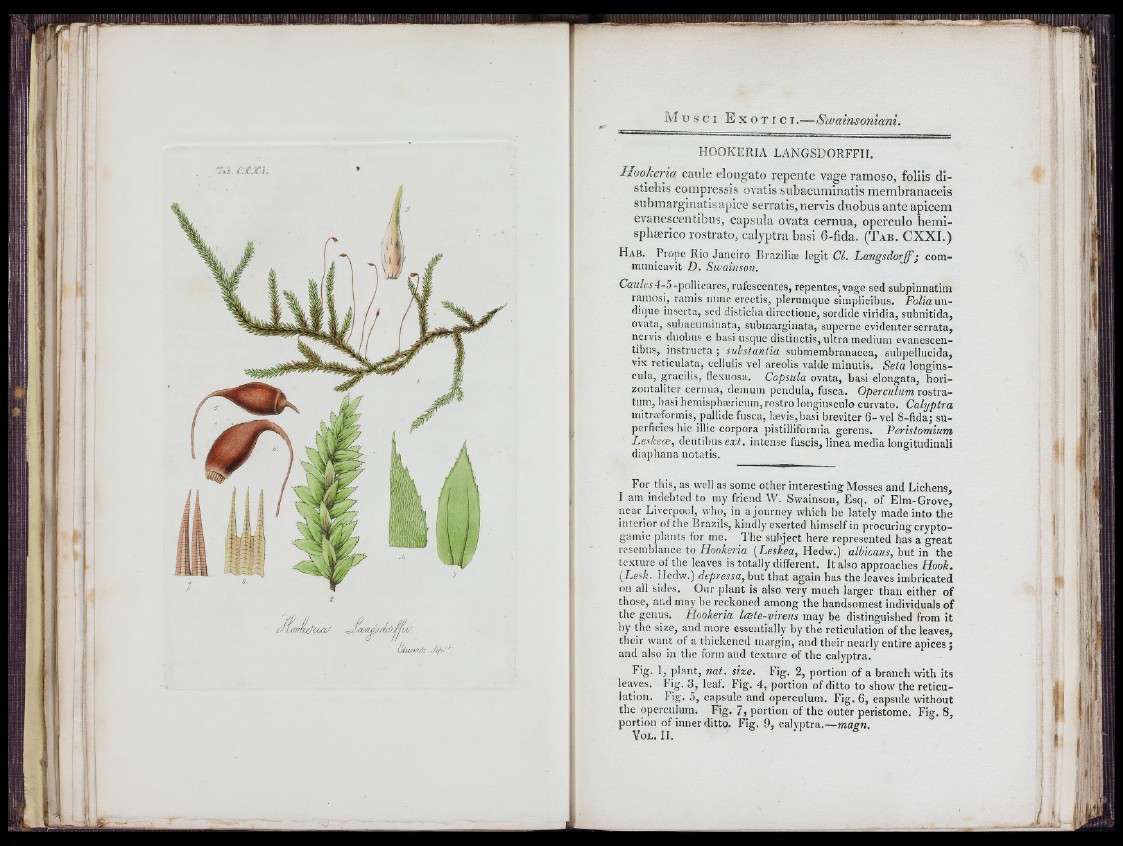
Cai. acM.
i/ÌjnrÌAiyM j 7 4 /n f!ir//fu y .
l^À/jn/ìài
\\
i-.v-
*: _ l i iil
HOOKERIA LANGSDORFFH.
Hookeria caule elongato repente vage ramoso, foliis distichis
compressis ovatis subacuminatis membranaceis
subinarginatis apice serratis, nervis duobus ante apicem
evanescentibus, capsula ovata cernua, operculo hemi-
sphærico rostrato, calyptra basi 6-fida. (Tab. CXXI.)
Ha b . Prope Rio Janeiro Braziliæ legit Cl. Langsdorff; cotn-
municavit D. Swainson.
Gaz/Ai4-5 -pollicares,rufescentes, repentes,vage sed subpinnatim
ramosi, ramis mine erectis, plerumque simplicibus. Foliaxm-
dique inserta, sed disticha directione, sordide viridia, subnitida,
ovata, subacuminata, submarginata, superne evidenter serrata,
nervis duobus e basi usque distinctis, ultra medium evaiiescen-
tibus, instructa ; siilstanlia submembranacea, subpellucida,
vix reticulata, cellulis vel areolis valde minutis. Seia longiuscula,
gracilis, flexuosa. Capsula ovata, basi elongata, horizontaliter
cernua, demum pendula, fusca. OpercuLumxostxdi-
tum, basi hemisphæricum, rostro longiu.sculo curvato. Calyptra
initræformis, pallide fusca, lævis,basi breviter 6- vel S-fida; superficies
hic illic corpora pistilliformia gerens. Peiistomìum
Leskeæ, dentibus ea;i. intense fuscis, linea media longitudinali
diaphana notatis.
For this, as well as some other interesting Mosses and Lichens,
I am indebted to my friend W. Swainson, Esq. of Elm-Grove,
neaiyLiverpool, who, in ajourney which he lately made into the
interior oi the Brazils, kindly exerted himself in procuring cryptogamie
plants for me. The subject here represented has a great
resemblance to Hookeria {Leskea, Hedw.) albicans, but in the
texture of the leaves is totally different. It also approaches Hook,
[Lesk. Hedw.) depressa, but that again has the leaves imbricated
on all sides. Oiir plant is also very much larger than either of
those, and may be reckoned among the handsomest individuals of
the genus. Hookeria loete-virens may be distinguished from it
by the size, and more essentially by the reticulation of the leaves,
their want of a thickened margin, and their nearly entire apices ;
and also in the form and texture of the ca^'ptra.
F'g- E plant, nat. size. Fig. 2, portion of a branch with its
leaves. Fig. 3, leaf. Fig. 4, portion of ditto to show the reticulation.
Fig. 5, capsule and operculum. Fig. 6, capsule without
the operculum. Fig. 7, portion of the outer peristome. Fig. 8,
portion of inner ditto. Fig. 9, calvptra.—magn.
Vol. II.
I